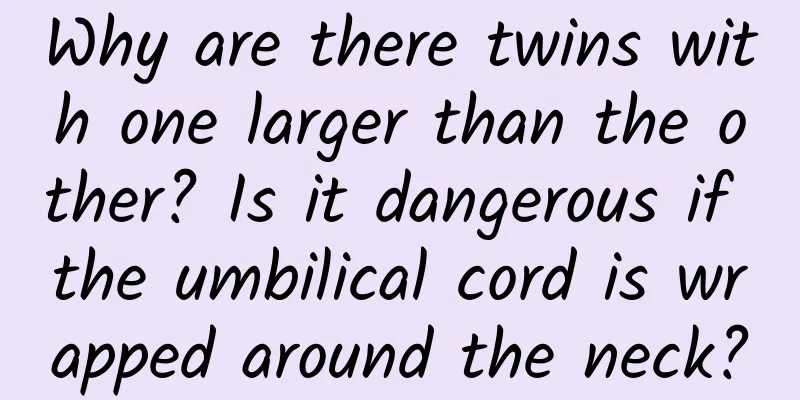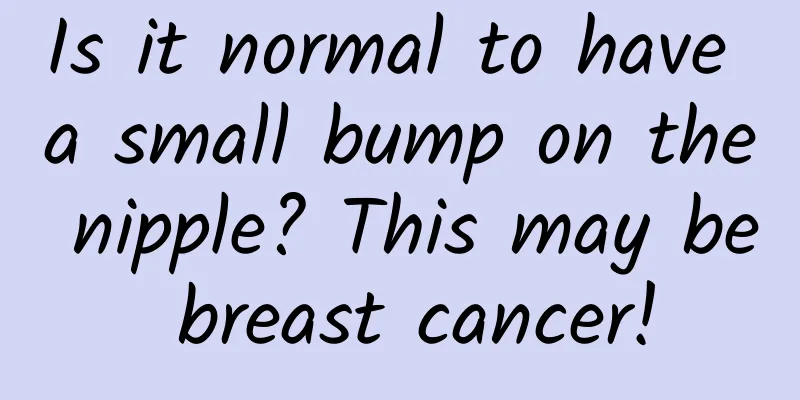Why are there twins with one larger than the other? Is it dangerous if the umbilical cord is wrapped around the neck?

|
Author: Sun Yu, Chief Physician, Peking University First Hospital Reviewer: Zou Liying, Chief Physician, Beijing Obstetrics and Gynecology Hospital, Capital Medical University Most parents say that twins often quarrel and fight at home. It seems that they are at war 24 hours a day except for sleeping. It is really a headache and much more difficult to raise than single babies. In fact, twins are more worrying than single babies before they are born. What is the reason for twins to have one larger than the other? What should be done if one of the twins dies in utero during a twin pregnancy? Is it dangerous for the twins to have the umbilical cord wrapped around their necks or entangled? Let's take a look. 1. What happens when one twin fetus is larger than the other? Under ultrasound, we can estimate the weight of the fetus. If the weight of twins is one larger than the other, it mainly depends on how big the difference is. If we estimate that the weight difference between the two fetuses is very small, such as only 10%, this is a normal phenomenon. If we estimate that the weight of the two fetuses differs by more than 25%, it is considered abnormal and is called twin development discordance, which is a pathological concept. In fact, it is related to the chorionicity. If it is dichorionic, the two fetuses have their own placentas. One is larger than the other. This is often related to the development of the fetuses themselves, or to the size of the placentas. It may be that one of the two placentas is larger and the other is smaller, so the two fetuses are also larger and smaller. Figure 1 Original copyright image, no permission to reprint In the case of dichorionicity, if one fetus is small, the small fetus may have a series of problems later on, such as malnutrition, hypoxia, and even some small fetuses are so serious that they may suffer intrauterine fetal death. However, its impact on the larger fetus is not great because they are two independent beings. However, if it is monochorionic twins and one fetus is small, we call it selective fetal growth restriction. This is a special concept for monochorionic twins. According to the ultrasound characteristics of the end-diastolic umbilical artery of the small fetus, it is divided into type I, type II, and type III. These three different types are related to the size of the fetus and blood flow. Different categories have different treatment measures, and for twin selective fetal growth restriction, type I has a relatively better prognosis, but even if the prognosis is better, iatrogenic premature birth is inevitable. According to the current twin guidelines, it is recommended to terminate the pregnancy between 34-36 weeks, so premature birth is inevitable, and this is when the child is relatively well developed and there are no complications. If it is type II or type III, the gestational age of delivery will be earlier. Basically, we recommend considering termination of pregnancy around 30 or 32 weeks. Therefore, the incidence of iatrogenic premature birth will be higher, and the gestational age will occur earlier. In addition, the fetus is small, so the perinatal mortality rate will be relatively high, and the fetal brain damage is also more likely to occur. So this is where it gets complicated. When dealing with it, doctors need to analyze more and then choose different treatment plans for different individuals. 2. What to do if one fetus in a twin pregnancy dies in utero? When one of the twins dies in utero, we have no way to take the dead fetus out, but there is no need to take it out either, because as the other fetus grows bigger, this fetus will be pressed aside and gradually shrink, eventually forming a paper-like shape, which means it is as thin as paper, and will be delivered together with the placenta. But we must note that if one fetus dies intrauterine, it may have an impact on the other fetus that remains. Of course, if it is dichorionic twins, no special treatment is required after one fetus dies in utero, and the impact on the other child is generally very small. But if it is due to the mother's reasons, such as the mother has serious complications such as high blood pressure, we have to be careful and consider the possibility of affecting the other fetus and causing intrauterine fetal death. If it is monochorionic twins, spontaneous intrauterine fetal death occurs in one fetus, it may also affect the other fetus. The effects on the other fetus may include severe blood loss, anemia due to massive blood loss, and even brain damage due to cerebral ischemia. Figure 2 Original copyright image, no permission to reprint Therefore, for monochorionic twins, if one fetus dies in utero, we need to regularly monitor the brain development of the surviving fetus and whether there is anemia. These problems can be discovered through ultrasound examinations and magnetic resonance imaging of the fetal brain. 3. Is it dangerous for a twin pregnancy to have the umbilical cord wrapped around the neck or entangled? Generally speaking, in a twin pregnancy, there is not much difference between having the umbilical cord wrapped around the neck of one fetus and having the umbilical cord wrapped around the neck of a single fetus. It should be said that the more dangerous is the monochorionic and monoamniotic twin pregnancy. There is no diaphragm between the two twins, living in the same "room". At this time, it is not just a problem of the umbilical cord around the neck, but more importantly, the problem of the umbilical cords being entangled with each other, that is, the umbilical cords of the two fetuses are entangled together, so this situation is actually the most dangerous. Figure 3 Original copyright image, no permission to reprint Because the fetuses are always moving, moving around in the uterus will pull on their respective umbilical cords, and one day the cords may become tied and both fetuses may have no chance of survival. Therefore, monochorionic and monoamniotic twins are the most dangerous, and sudden death of both fetuses may occur at any time. However, for umbilical cord around the neck, whether it is a single or twin baby, we don’t need to worry too much about it, or want to prevent it, because the umbilical cord around the neck is changing. Although today’s B-ultrasound tells you that the umbilical cord is around the neck, it is very likely to be out tomorrow because the fetus is moving. So, you don’t need to pay too much attention to the umbilical cord around the neck. Pregnant women should pay more attention to their fetal movements. If you are worried about the umbilical cord around the neck causing fetal hypoxia, it will be reflected in the fetal movement, so you should monitor the fetal movement every day in the third trimester. This is more meaningful than wondering every day whether my child has the umbilical cord around the neck. |
<<: There are currently two main methods to screen for ovarian cancer and prevent ovarian cancer!
Recommend
Animal cream, vegetable cream, don't be confused
Cream cakes have always been popular among the pu...
World Asthma Day丨How can we breathe more comfortably and freely?
Today (May 3) is World Asthma Day. In recent year...
How to detect endometrial polyps
Uterine intrauterine polyps are a gynecological d...
What kind of tea can help you get bigger breasts?
Scented tea is also commonly known as flower and ...
What causes premenstrual vulvar itching?
Many women will feel vulvar itching before menstr...
The dangers of breast augmentation
Breasts are a woman's pride, especially in th...
Does a hair dryer have a lot of radiation on pregnant women?
After pregnancy, you need to avoid things with ra...
Is the brain a parasite?
Some time ago, I saw a netizen ask, "Is it p...
What causes vaginal bleeding in women?
Nowadays, female friends usually have to go out t...
How to repair the color difference of car paint? How to spray the car paint if it needs to be over-colored?
Car painting refers to applying a layer of paint ...
Brown bloody vaginal discharge itchy for a week
Leucorrhea is generally a white, odorless, mucous...
Pregnant women should keep these principles in mind to protect their stomachs!
Pregnant women often feel some acid reflux, indig...
What is the method to enlarge breasts in 5 minutes a day?
In order to quickly improve their charm, many you...
To prevent falls in the elderly, remember these 7 things!
Falling is not a trivial matter for the elderly. ...
Can I keep a child if I have gestational hypertension?
During pregnancy, women's bodies are usually ...









